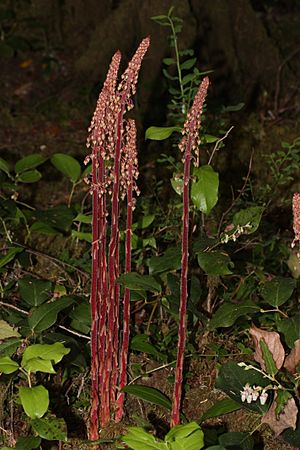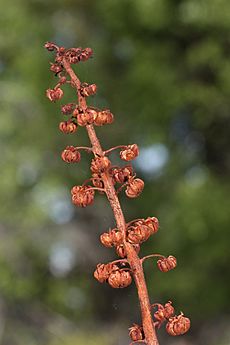Pinedrops facts for kids
Quick facts for kids Pinedrops |
|
|---|---|
 |
|
| Scientific classification | |
| Genus: |
Pterospora
|
| Species: |
andromedea
|
Pinedrops, also known as woodland pinedrops or giant bird's nest, is a unique plant found in North America. It belongs to the heath family, Ericaceae. There is only one species in its group, called Pterospora andromedea.
This plant grows in forests with cone-bearing trees or mixed forests. You can find it across Canada, the western and northeastern United States, and northern Mexico. It is one of the more common plants in its subfamily, Monotropoideae.
The name Pterospora comes from the Greek words pteron (wing) and spora (seed). This is because its seeds have thin, wing-like flaps. The name andromedea comes from how its flowers look like those of another plant, Andromeda, which is also in the heath family.
What Pinedrops Look Like
The part of the pinedrops plant you see above ground is a thick, unbranched stalk. It can be reddish to yellowish in color. This stalk is a flower spike, which is called a raceme.
It usually grows to be about 30 to 100 centimeters (12 to 39 inches) tall. Sometimes, it can even reach up to 2 meters (6.6 feet) in height. These stalks usually grow in small groups. You can often spot them between June and August.
The stalks are hairy and feel very sticky if you touch them. This stickiness comes from special hairs that release a sticky substance. The stalks are also covered by small, scale-like parts called bracts. The top part of the stalk has many yellowish, urn-shaped flowers. These flowers hang downwards. After the flowers, the plant produces a fruit that is a capsule. Most of the plant's life is spent as a mass of roots underground. These roots are brittle but thick.
How Pinedrops Get Food
Pinedrops, like all plants in its group (Monotropoideae), are called mycoheterotrophs. This means they get their food in a very special way. They do not make their own food using sunlight like most plants. Instead, they get their carbon (energy) from fungi.
These fungi are connected to other green, photosynthetic plants, usually trees. So, pinedrops are like parasites on the fungi. The fungi, in turn, get food from the trees. Pinedrops do not have chlorophyll, which is the green pigment plants use for photosynthesis. Because of this, they must rely on this relationship to survive.
Pinedrops are very picky about which fungi they connect with. In the western parts of North America, they mostly work with a fungus called Rhizopogon salebrosus. In the eastern areas, they prefer Rhizopogon kretzera. Generally, they partner with fungi from the Rhizopogon subgenus Amylopogon.
These Rhizopogon fungi are also specific about their partners. The Amylopogon group mainly connects with pine trees. For pinedrops seeds to sprout, they need special enzymes from these fungi. Even though other fungi might have these enzymes, pinedrops only grow with their specific fungal partners. Scientists are still studying why this is.
See also
 In Spanish: Pterospora andromedea para niños
In Spanish: Pterospora andromedea para niños


